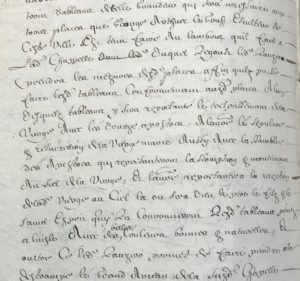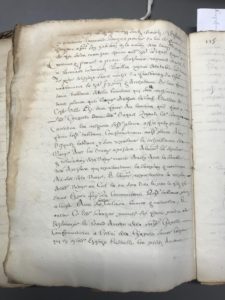

La recherche est un travail de patience, souvent ingrat, mais le plus souvent magique. Je partage avec vous ce texte dont la côte m’a été donnée par des amis des archives, je l’ai transcrit en partie pour vous, voyez comme l’on peut au hasard (ou pas) du déchiffrement des liasses faire revivre l’activité artistique de Toulouse. Dans un prochain billet, j’ouvrirai en grand les portes des collectionneurs érudits de la ville. Et là il y a matière à émerveillement!
Lozero, quant à lui était selon le texte, un peintre originaire de Florence. Le 19 mars 1651 il s’installe chez la veuve d’un marchand épicier, et s’engage par contrat auprès des bailles régents de la table de Notre-Dame de Pitié, de l’église Saint Michel du faubourg du Château Narbonnais, de Toulouse… il s’engage, disais-je, à peindre … et le contrat précise le nombre et la description des tableaux:
« trois tableaux de telle grandeur qui sera nécessaire aux trois places que Georges Arthur Legoust esculpteur de cette ville est tenu faire (la place) … desquels tableaux y sera représenté le trespassement de la Vierge avec les douze apôtres, et l’autre, le sépulchre et résurrection de la vierge Marie aussi avec l’assemblée des apostres qui représenteront l’assomption et montement au ciel de la Vierge, et l’autre représentation de la dite vierge au ciel ou sera Dieu le père et fils et le Sainct-Esprit qui la couronneront; les dits tableaux peints à l’huile avec des couleurs belles et naturelles. Et oultre le dit Lozero promet de faire peindre à la destrampe le grand arceau de la susdite chapelle »…
Nota: Georges Arthur Legoust était « le fils du célèbre Arthur Legoust, il était marié à Antoinette Morizot, veuve en premières noces du peintre Jean Fredeau et habitait 9 rue Boulbonne ». in « l’Auta », Octobre 1983, p 254.
Research is a work of patience, often thankless, but more often than not magical. I share with you this text given to me by friends of the archives, I transcribed it partly for you, see how randomly (or not) we can decipher the texts to revive the artistic activity of Toulouse in France. In a next post, I will open wide the doors of the city’s great collectors. And there is something to be amazed about!
Lozero, was a painter from Florence in Italy. On March 19, 1651 he settles down at the home of the widow of a grocery storekeeper, and enters into a contract with the regent of the table of Notre Dame de Pitié, of Saint Michel church in the suburb of the Château Narbonnais de Toulouse… he undertakes, as I said, to paint… and the contract specifies the description of the paintings:
« three paintings of such greatness that will be necessary for the three places that Georges Arthur Legoust, sculptor of this city, is required to make (the place)… paintings will represent the transcendence of the Virgin with the twelve apostles, and the other, the sepulchre and resurrection of the Virgin Mary also with the assembly of apostles who will represent the assumption and ascension to heaven of the Virgin, and the other representation of the said Virgin in heaven where God the father and son and the Holy Spirit who will crown her; the so-called oil paintings with beautiful and natural colours. And besides, Lozero promises to have the great arch of the aforementioned chapel painted to.

